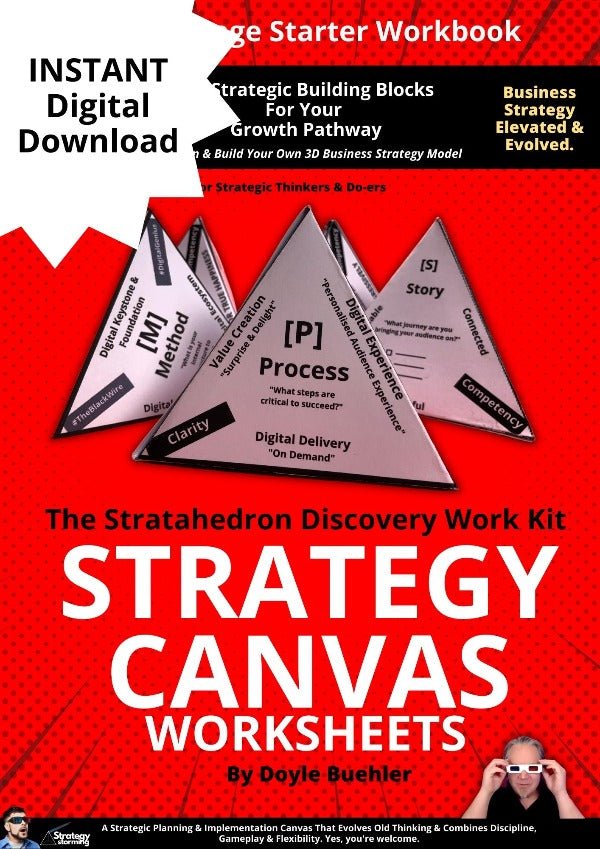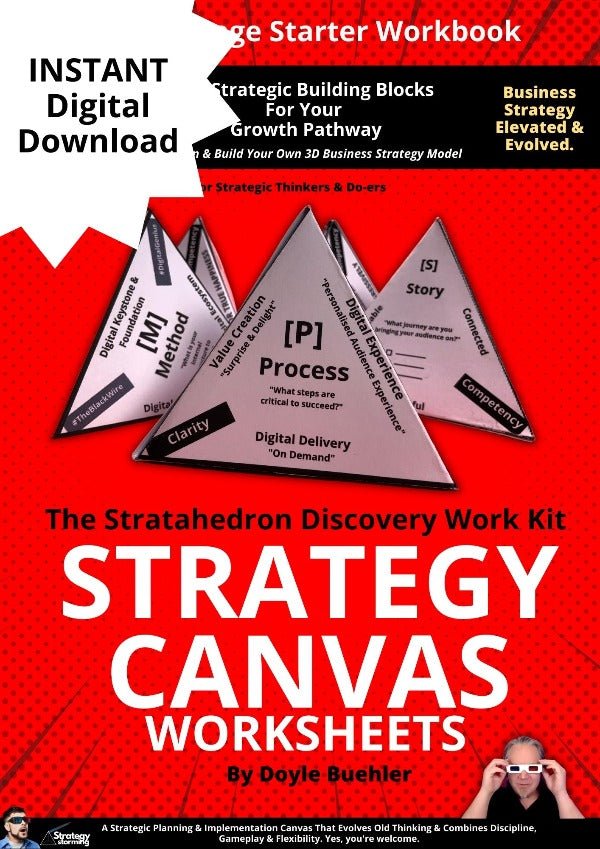Innovation is the key to staying ahead in today's competitive business landscape. Are you using it properly for Growth?
How do you ensure that your innovation efforts are focused and effective? The answer lies in strategic planning. By incorporating a well-defined strategy into your innovation process, you can maximize your chances of success and create a culture of innovation within your organization.
Understanding the Connection Between Strategy and Innovation
Before we dive into the specifics of how to use strategy to improve innovation, let's first explore the relationship between the two. Strategy, in the context of business, refers to the long-term plan that guides an organization in achieving its goals. It involves analyzing the current situation, setting goals, and determining the best course of action to achieve those goals. Strategy takes into account factors such as market conditions, competition, and available resources.
Innovation, on the other hand, involves the development and implementation of new ideas and solutions that create value. It is not just about coming up with new ideas; it's about implementing those ideas in a way that creates value. By constantly innovating, organizations can stay ahead of the competition, attract new customers, and even create new markets.
By aligning your innovation efforts with your business strategy, you ensure that your innovative ideas are not just random shots in the dark, but rather targeted solutions that address your organization's specific needs and goals. Having a well-defined strategy provides a roadmap for your innovation efforts. It helps you prioritize your resources, identify opportunities for innovation, and assess the potential risks and challenges that may arise along the way.
Get your Strategy Planning Checklist Here.
Defining Strategy in Business
To use strategy to improve innovation, it's important to have a clear understanding of what strategy entails. In business, strategy involves analyzing your current situation, setting goals, and determining the best course of action to achieve those goals. It takes into account factors such as market conditions, competition, and resources available.
Having a well-defined strategy provides a roadmap for your innovation efforts. It helps you prioritize your resources, identify opportunities for innovation, and assess the potential risks and challenges that may arise along the way. Strategy is not a one-size-fits-all approach; it needs to be tailored to the specific needs and goals of your organization.
When developing your strategy, it's important to involve key stakeholders from across your organization. This ensures that everyone is aligned and working towards a common goal. It also allows for diverse perspectives and ideas to be considered, which can lead to more innovative solutions.
The Role of Innovation in Growth
Now that we've explored the concept of strategy, let's delve into the role of innovation in driving growth. Innovation is not just about coming up with new ideas; it's about implementing those ideas in a way that creates value. By constantly innovating, organizations can stay ahead of the competition, attract new customers, and even create new markets.

When aligned with a well-defined strategy, innovation becomes a powerful tool for growth. It enables organizations to differentiate themselves from their competitors, improve their products and services, and find new ways to meet the evolving needs and expectations of their target audience.
Innovation can take many forms, from incremental improvements to radical breakthroughs. It can involve changes to products, processes, or business models. The key is to constantly challenge the status quo and look for opportunities to innovate.
Successful innovation requires a culture that encourages and rewards creativity and risk-taking. It requires a mindset that embraces change and sees failure as an opportunity to learn and improve. Organizations that foster a culture of innovation are more likely to succeed in today's fast-paced and ever-changing business environment.
Get your Strategy Planning Checklist Here.
The Importance of Strategic Planning for Innovation
Now that we understand the connection between strategy and innovation, let's explore why strategic planning is crucial for successful innovation.
In today's rapidly changing business landscape, innovation has become a key driver of growth and competitiveness. Organizations that fail to innovate risk being left behind by their competitors. However, innovation cannot happen in isolation. It needs to be guided by a strategic plan that aligns it with the overall goals and objectives of the organization.
Get your Strategy Planning Checklist Here.
Aligning Innovation with Business Goals
Strategic planning allows you to align your innovation efforts with your overall business goals. By clearly defining your goals and objectives, you can ensure that your innovation initiatives are focused and purposeful. This alignment ensures that your innovation efforts contribute directly to the growth and success of your organization.
For example, if one of your business goals is to increase market share, your strategic plan can guide your innovation efforts towards developing new products or services that will help you capture a larger share of the market. By aligning innovation with business goals, you can avoid wasting resources on ideas that do not contribute to the organization's strategic objectives.
Furthermore, strategic planning enables you to identify the areas in which innovation is most needed. It helps you identify gaps in the market or areas where your organization is falling behind its competitors. By focusing your innovation efforts on these areas, you can gain a competitive advantage and position your organization as a leader in the industry.
Prioritizing Innovation Initiatives
Strategic planning also helps in prioritizing your innovation initiatives. With limited resources, it is important to invest in projects that have the highest potential return on investment. By carefully assessing the potential impact and feasibility of each idea, you can allocate your resources effectively.

For instance, if you have multiple innovation ideas, strategic planning can help you evaluate each idea based on its potential market demand, technical feasibility, and financial viability. This evaluation process allows you to prioritize ideas that have the greatest potential for success and allocate resources accordingly.
Moreover, strategic planning helps you avoid the common pitfall of spreading your resources too thin. Without a strategic plan, it is easy to get caught up in the excitement of new ideas and start multiple projects simultaneously. However, this approach often leads to diluted efforts and limited results. By prioritizing innovation initiatives through strategic planning, you can focus your resources on a few key projects and increase the likelihood of their success.
Strategic planning is crucial for successful innovation. It aligns innovation with business goals, ensuring that your efforts contribute directly to the growth and success of your organization. It also helps in prioritizing innovation initiatives, enabling you to allocate resources effectively and increase the potential return on investment. By incorporating strategic planning into your innovation process, you can position your organization as a leader in the industry and drive sustainable growth.
Get your Strategy Planning Checklist Here.
Developing an Effective Innovation Strategy
Now that we understand the importance of strategic planning, let's explore how to develop an effective innovation strategy.
Identifying Opportunities for Innovation
Effective innovation starts with identifying opportunities for improvement and growth. This could involve analyzing market trends, conducting customer surveys, or brainstorming ideas with your team. By understanding the needs and desires of your target audience, you can uncover new opportunities and develop innovative solutions.
Setting Clear Innovation Objectives
Once you've identified opportunities for innovation, it's important to set clear objectives. Your objectives should be specific, measurable, achievable, relevant, and time-bound (SMART). They provide a clear direction for your innovation efforts and serve as a benchmark for measuring success.
Implementing Your Innovation Strategy
Now that you have a well-defined innovation strategy, it's time to put it into action.
Building a Culture of Innovation
A strong culture of innovation is essential for successful implementation of your strategy. Create an environment that encourages creativity, risk-taking, and collaboration. Foster a culture where employees feel empowered to share their ideas and experiment with new approaches. By nurturing a culture of innovation, you pave the way for the successful implementation of your strategy.
Monitoring and Adjusting Your Innovation Strategy
Implementing your innovation strategy is not a one-time event; it's an ongoing process. Regularly monitor your progress and adjust your strategy as needed. Seek feedback from your team and customers to ensure that your innovation efforts are on track. Adapt to changing market conditions and embrace new opportunities as they arise.
Get your Strategy Planning Checklist Here.
Overcoming Challenges in Strategic Innovation
While strategic innovation offers immense benefits, it also comes with its fair share of challenges. Let's explore how to overcome these challenges and ensure the success of your innovation efforts.
Dealing with Resistance to Change
Change can be met with resistance. When implementing your innovation strategy, expect pushback from those who are comfortable with the status quo. To overcome resistance, communicate the benefits of change, involve key stakeholders in the decision-making process, and provide training and support to help employees adapt to the new ways of doing things.
Ensuring Sustainability of Innovation Efforts
Innovation is not a one-time event; it's an ongoing journey. To ensure the sustainability of your innovation efforts, create a system for continuous improvement. Regularly review your innovation strategy, learn from both successes and failures, and implement mechanisms to capture and implement new ideas from your employees and customers.
How Do You Use Strategy To Improve Your Innovation Capabilities?
Using strategy to improve innovation is a powerful approach that enables organizations to stay ahead in an ever-changing business landscape. By aligning innovation with business goals, developing a clear strategy, and implementing it effectively, organizations can create a culture of innovation and drive growth. Overcoming challenges and adapting to change are essential for sustaining innovation efforts in the long run. So, embrace strategy, embrace innovation, and watch your organization thrive in the face of uncertainty.
Get your Strategy Planning Checklist Here.


![The Entrepreneur Journey is Broken? [Part 1] - Strategystorming - The Strategy Studio & Shop for Strategic Thinkers](http://strategystorming.co/cdn/shop/articles/the-entrepreneur-journey-is-broken-part-1-590109.webp?v=1701206679&width=180)












































![#SmartStrategy [Designing Your Strategy For Business] - Strategystorming - The Strategy Studio & Shop for Strategic Thinkers](http://strategystorming.co/cdn/shop/articles/smartstrategy-designing-your-strategy-for-business-256943.jpg?v=1693515536&width=180)





